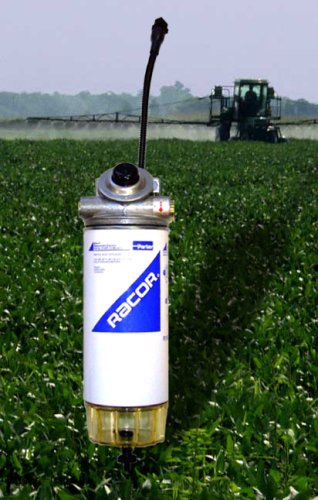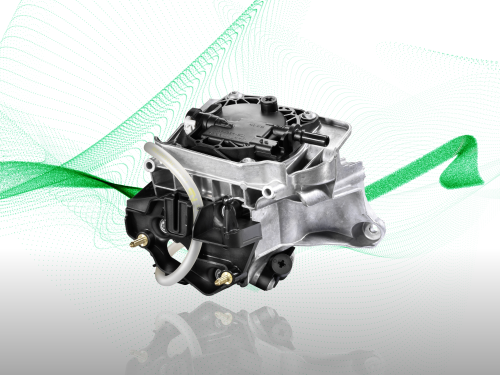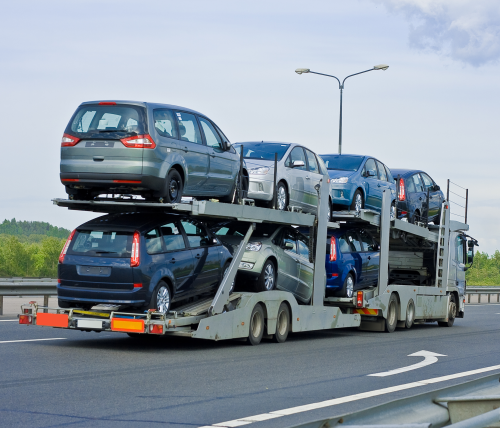


In-line separation technology
We now outline the modern trend of automotive vehicle manufacturers seeking higher filtration quality and water separation through the installation of in-line fuel filters within the vehicle or industrial engine. We have seen that contamination in fuel, in the form of water or particulates, can spell disaster in diesel fuel injection systems, especially in high pressure common rail injection (HPCR) systems. This is due to the extremely high pressures at which they operate. Moisture ingress occurs inside storage tanks or vehicle tanks, with condensation on the walls of the tank falling into the fuel, while particulate contamination can been picked up by the fuel at various points in the supply chain.
Racor innovations
“First and foremost,” Adam Pearce, fuel product manager at Parker Hannifin’s Racor Division, explained, “the primary function of diesel filtration is to prevent contaminants in the fuel reaching the engine injection system. This is the fundamental capability upon which all market solutions are built. Thereafter, filtration efficiency, durability and maintenance are typically among the factors that determine filter selection.” “Yet there remains ongoing innovation to improve all aspects of automotive diesel filtration, including operating life and total cost of ownership.” “But with some estimates suggesting that up to eight out of every ten diesel engine injection system failures result from contaminated fuel, more and more commercial vehicle manufacturers are realising the economic benefit of fitting their engines with pre-filtration systems.” Parker Hannifin’s Racor division manufactures fuel filters that combine the functions of a particulate filter and water separator in a single system, offering filtration grades as low as the 2μm rating required in the medium term. “What’s more,” Pearce explains, “models such as our 400 Series HH feature a filter head that now includes a ‘positive temperature coefficient’ heater to warm the fuel as it passes through the filter, reducing further any possibility of the filter or fuel lines becoming blocked due to waxing-up of the fuel at low ambient temperatures.” The Racor HH unit is shown in Figure 4. Such fuel heaters are not uncommon on diesel engines, but Racor state that the HH heater self-regulates the power it draws depending on temperature and flow. Operating on a range of voltages from 12-42 V DC, the heater will safely power down when there is no fuel flow through the line. Pearce added: “Parker Racor is also leading the market with advanced thermal fuel recirculation technology that is integrated into the filter head and shows great improvements in cold start environments.” “The cost implications of adding a fuel line filter to a vehicle that may already have an on-engine filter are easily outweighed by the replacement costs of a new injection system if it becomes damaged by contaminated fuel. A fuel line filter typically costs no more than 25% of the cost of a tank of fuel.” Looking at the legislative environment, Pearce went on to explain that there are additional factors beginning to move up the priority list when it comes to filter selection for diesel engine applications. “For example,” he said, “Euro 6 is set to be the most stringent European emission standard to date when it becomes mandatory for all new heavy trucks in January 2014. “However, while commercial vehicle manufacturers groan under the burden of yet more legislation, there are already ways that fuel filters can make diesel engines more environmentally friendly and reduce lifetime costs.” As well as protecting engines against water and particulate contamination, Racor says that the HH filter has also been designed specifically for the latest breeds of low sulphur fuels and biodiesels. With sulphur levels now reduced to a maximum of 10 ppm since 2009 (EN 590), these fuels are much more susceptible to waxing than the earlier higher sulphur containing fuels prior to 2009. Also, biodiesel can often be contaminated with far more dirt than traditional fossil fuels, which can lead to premature clogging of on-engine fuel filters. Some carbon-neutral fuels such as biodiesel and biodiesel blends (and ultra-low sulphur diesel) pose new challenges for engine manufacturers. “Here,” explained Pearce, “latest-generation filtration technology can provide effective solutions. “When run on certain biofuels, fuel filters in diesel engines can quickly clog with particulates, particularly in cold conditions, causing a vehicle to break down completely in some cases. Furthermore, biodiesels are much better solvents than conventional diesel, and will break down existing agglomerates and dirt in older vehicles and further contaminate the fuel system. End users are therefore advised to change the fuel filter within 800 miles of first switching to a biodiesel blend.” According to Racor, the HH filter assembly has been designed with these modern fuels in mind. It is equipped with a 10μm rated filter element, a high capacity see-through water collection bowl and a built in primer pump, allowing the filter to cope with the typical levels of contamination that might be expected in a biodiesel. “And there are knock-on benefits too,” Pearce concluded. “For example, biodiesel has a higher lubricity index compared to fossil fuel equivalents, which contributes to longer fuel injector life in diesel engines. Furthermore, biodiesel is a better solvent and has been known to break down deposits of residue in the fuel lines of vehicles that have previously been run on conventional diesel. Ultimately, it seems biofuels may prove to be enginefriendly, not just environment-friendly.”
Mann + Hummel innovations
Further discussions with Mann + Hummel have confirmed that the rapidly changing legislation for new diesel vehicle emissions in all regions of the world, the increased requirements for the new generation of HPCR systems and the variety of globally available fuel qualities requires different and highly specialised filter systems. “This creates new challenges for vehicle manufacturers, engine producers, injection system manufacturers and filtration suppliers,” Gunnar-Marcel Klein, vice-president of engineering filter elements at Mann + Hummel, explained. “Regardless of the fuel quality in the future a consistent fuel cleanliness level must be supplied to the injection system. Especially in some parts of Asia, where fuel quality is not yet at the level of Europe or North America, this shift generates the need to develop filtration systems of better quality than those supplied today.” “We have set various milestones of high performance filter media in diesel fuel filters over the last decade”, added Klein, “starting with the launch of our patented meltblown-based composite media Multigrade F-HC in 2002”. This achieved β4>5 (ISO 19438). Despite the increase of the filtration efficiency by a factor of 3 compared to single layer cellulose based filter media, the dust holding capacity and filter service interval has been increased by more than 50%. The subsequent launch of ever finer ‘Multigrades’ like F-HE (β4>20) and F-HE+ (β4>50) continued this development. “We are now launching the latest Multigrade development,” Klein explained. The newly developed F-HE++, which exhibits β4>300, has recently had the first serial launch in a HPCR industrial heavy duty engine application. “The filter media is able to reach this outstanding performance level by utilising polymeric nanoscale fibres in the depth of the filtering composite media,” Klein added. “Several other automotive and industrial engines will be equipped with this latest technology during the next few years.” In addition to this in-line technology, Mann + Hummel is developing new filtration approaches to fulfill the expected diesel fuel cleanliness levels for future engine generations, especially for operation in regions with lower fuel qualities like Asia. “Fully synthetic, nanofibre-based composite media with efficiencies in the range of Beta 4 values of 10,000 and above are in preparation,” Klein confirmed. Another innovative approach to the removal of water from diesel fuel is the three stage water separator from Mann + Hummel. This achieves the required purity for finely dispersed water-in-diesel emulsions by enlarging the water droplets before they are separated from the fuel. Klein went on to explain that “the new water separator technology can be integrated into existing installation spaces. The first stage uses a fine coalescing filter media on which small emulsified water droplets in the diesel accumulate before coalescing into larger drops.” “In the second stage, the volume of these drops is enlarged via downstream coalescer layers. The flow in the water separator is designed so that large drops from the fuel are separated via gravity alone. A hydrophobic barrier media provides the third filtration stage, acting as a final barrier for any remaining water droplets.” Mann + Hummel claims that the main advantage of this newly developed system is the location of the major water separation stages (the coalescer layers and the final hydrophobic barrier) downstream of the particle filtration composite media. Therefore, a high degree of water separation efficiency is achieved constantly during operation in dirty fuels, ensuring the protection of diesel injection systems over the whole service interval of the filter element. “This new concept in water separation,” Klein explained, “is currently being implemented in prototypes and validated via field tests. In addition, the findings we are compiling are being incorporated both into test standards for the validation of water-diesel separator performance, and directly into customer water-diesel separation projects. By collaborating very closely with vehicle and engine manufacturers, our innovative portfolio is constantly expanding to anticipate solutions for upcoming challenges and to meet customer demand.”
Conclusion
We have seen a number of innovations involved in the filtration and separation of particulates and water from different types and blends of diesel and biodiesel. We have investigated advances in filtration media and the in-line application of such media local to the diesel engine. We have also seen the importance of fuel conditioning to help ensure an enhanced quality prior to reaching the engine. The growth of emerging markets will continue to be a main driving factor in this area as the need for effective fuel conditioning, filtration and separation continues to spread into markets such as China. Legislation to reduce emissions will continue on a downward trend with developing economies following the European and North American lead. And, despite the debate on the advantages and disadvantages of using biofuels, it is likely that the ongoing drive for sustainable living will increase its impact on this industrial sector to drive forward further innovations.





